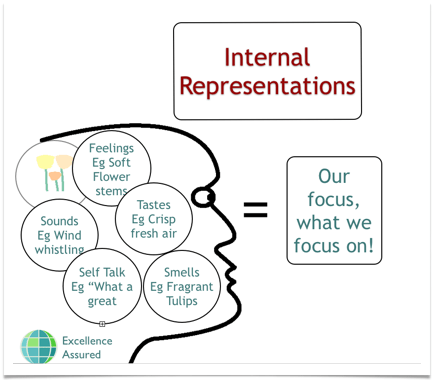You may not want to hear it but happiness is a choice. We choose to be happy or we choose not to be happy.
It doesn’t feel like you’ve got a choice most of the time though does it? Happiness seems to be dependent on whether or not good things happen to us, or not so good things, in which case we are sometimes distinctly unhappy.
Understanding the process that our mind goes through in order to create happiness and unhappiness is the first step in being able to be in control of your emotional state.
So, how does it all work?
Well, it’s all about how we filter the information that we take in through our senses and how we represent that information to ourselves, our internal representations.
Let’s tackle the filters first of all. What makes us filter the information that we take in? We use our senses to take in our world, senses of sight, sound, feel, taste and smell. These senses are very acute although we do not use each of them consciously all the time. Since they are so acute they provide us with lots and lots of information every second.
According to the Hungarian psychology professor, Mihaly Csikszentmihalyi we take in 2 million bits of information per second, and our brains as a processing unit can only cope with about 134 bits. That means that we have to lose an awful lot of information in order to be able to process our experience, so we filter it.
What we do to filter the information is we delete some of it, we distort some of it and we generalise, to save time.
Think of the word dog. Did you make a picture in your head of a dog? What did your dog look like? Was your dog small and timid, or was your dog a giant aggressive salivating monster? When we thought of a dog we generalised, we have templates in our minds of how to interpret our words, these templates are based on our past experiences and save us from having to find out all over again what the word means.
Look at the dot below. Close your left eye and look at the dot with your right eye only from about a foot away. Looking straight ahead move your head to the left, and as you move your head notice that the spot disappears and then reappears in your sight. This is deletion.
When I was a teenager I loved being left in the house on my own whilst my family went out but sometimes my mind went into overdrive, especially at night. We had a house with a creaky central heating system, and the pipes shrank when the heating went off, making all sorts of creepy noises. I used to lie in bed at night and listen out to make sure that there were no intruders in the house. Then I would hear a noise downstairs, then another, then another. By this stage I would be worrying, has someone broken in? Then another noise, and another.
Five minutes later I would be up and out of bed, listening intently. A creak on the stairs. I would hide behind my door convinced by now that there was someone in the house coming up the stairs.
Eventually I would pluck up the courage to peak to the top of the stairs. Come on, lets get this over with.
Nobody there.
My mind had distorted the sound of the central heating system cooling and had me terrified. Distortions are also positive for us in many ways since this is the origin of imagination, creativity and art.
Anyway, these are our filters. The information is deleted distorted and generalised and we are presented by our minds with internal representations. In the example above my mind represented the information to me as pictures of an intruder downstairs in my house, sounds of creaking floorboards as the intruder moved around.
These internal representations represent our reality. I believed 100% that there was an intruder in the house. There wasn’t, but I believed that there was, so my reality was that I was in danger. My state at that time as a result was one of fear, trepidation, nervousness. Not a positive state.
So, my mind had distorted reality, and left me in a really negative state. As a result my behaviour was to cower behind my bedroom door. This is the power of the mind.
Now at this time, what would it have taken to make me happy? Think about it. If, when I heard the first creak I had realised that it was just the central heating system cooling down, then I would have been totally happy, and probably fallen fast asleep.
That’s all it would have taken. After all, nothing actually happened to me, it was all mind generated. I made an unconscious decision that there was an intruder, and that made me terrified. These unconscious decisions are taking place all the time. That’s why sometimes you feel unhappy and can’t work out why.
The key to happiness therefore is to realise what is going on in your head. What internal representations are you generating in order to make you feel unhappy? What are your thought processes?
Once you have discovered the reason for your negative state, then you can consciously decide to change your internal representations, make them positive for you. If you have positive representations, then you will create in yourself a happy state.
That is why happiness is a choice. Start making conscious positive choices today.
NLP training online, NLP professional qualifications.

